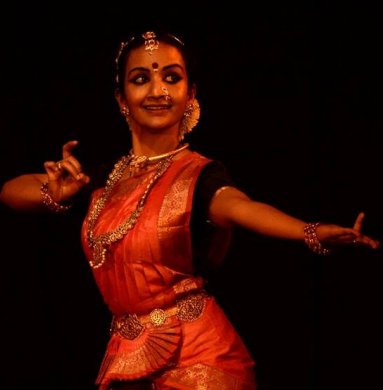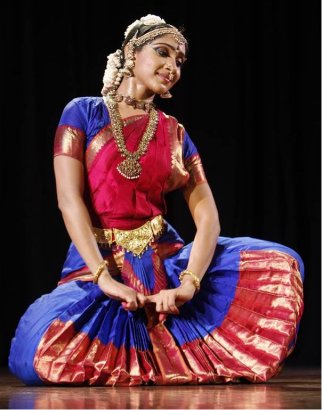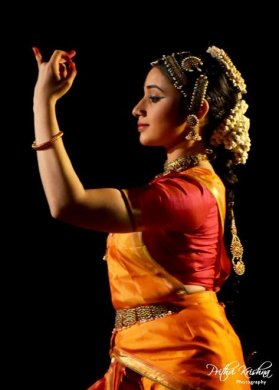
|   |

|   |
Delightful Nayikas of Thanjavur October 23, 2018 It is always a delight to find packed halls in Chennai for Carnatic kutcheris and Bharatanatyam performances. The Bharatiya Vidya Bhavan in Mylapore was packed for Natyanjali's 'Natya Utsav' dance festival on October 6 and 7, 2018. Day one opened with a rather unprepared dancer being presented on the stage. Sahana, a student of Lakshmanaswamy, could barely hold herself properly to perform in front of the august audience gathered there. Gurus must make sure their students are well groomed into the art form before they are presented. Sahana was visibly anxious. While there was nothing noteworthy about her presentation of the Thanjavur Quartet varnam 'Manavi chekona rada', it was only by the end piece of Muthuthandavar's 'Theruvil Varano' that she barely warmed up. She has a long way to go if she is interested in pursuing a full time career in dance.  Shruti Gopal This was followed by a fantastic solo performance by Bangalore's Shruti Gopal. With crisp nritta and pleasant and expressive abhinaya, it was a surprise to know this performance was one of the few solos Shruti was ever dancing in close to a decade. She began with a Purandaradasa kriti 'Sharanu Siddhi Vinayaka' in ragam Saurashtram. Choreographed by her Guru Padmini Ramachandran, Shruti was in the best form from the word go. Her presentation of the much-contested varnam 'Sarasa ninnippudu', the Telugu version of the famous 'Sumasayaka' attributed to Maharaja Swati Thirunal, was fresh. Her own capability for good nritta shone in the way she designed the jatis, changing different nadais from chaturasram to trisram and so forth. She concluded her performance with the popular Kanakadasa Devaranama 'Bagilenu teredu Hari', choreographed by her late guru. She had an excellent accompanying orchestra - Harsha Samaga's mridangam, G Srikanth's singing, Eshwar on violin, Jayaram Kikkeri on flute and Parshwanath Upadhye on nattuvangam.  Jyotsna Jagannathan Photo: Avinash Pasricha Following that was Jyotsna Jagannathan's performance that she opened with a 'Nandi Choll'. The composition with jatis fit in by mridangist Ramesh Babu seemed like a quick-fix attempt to design a piece based on the movement, rather than the other way round. The packed composition saw Jyotsna's dance scatter itself across way too much than a regular 'Choll' could have demanded. In Jyotsna's attempt at the classical Tanjore Quartet varnam, the ever-performed 'Mohamana', it was in the nritta sequences that Jyotsna's actual dance was seen. She concluded her performance with the famous Dasarapada 'Krishna nee begane baaro'. This song, popular only in the Carnatic stage was turned into a classic piece for Bharatanatyam by the iconic Balasaraswati. After that, very few have managed to do justice to its visual imagery. While Jyotsna was all warmed up to perform after her varnam, the abhinaya of this piece was too stylized to bring forth the emotions of a mother that the song finally encapsulates. She is undoubtedly a good performer, but she could certainly take a relook at whatever she presented that evening.  Meera Sreenarayanan Photo: Prithvi Krishna The second evening's performance opened with Meera Sreenarayanan's beautiful solo performance. Meera's petite constitution is a mask till she gets on stage. Her presentation of the famous Thanjavur Quartet varnam 'Danike' set to Thodi was impressive. However, Meera should be aware that every line written in most of these traditional compositions comes with layers of meaning beyond the physical. With her Guru Indira Kadambi on the nattuvangam, Bijeesh Krishna's melodious singing and Charudutt's excellent mridangam, Meera's inspiring performance had its moments of grace and stillness. Anita Guha's student Medha Hari performed the Thodi varnam composed by Pandanallur Meenakshisundaram Pillai. Medha's dance was full of energy, but the loud mridangam was in one shruti, and singer Murali Parthasarathy singing on the upper octave was in yet another different shruti. Medha is a good dancer, but must slow down a bit.  Roja Kannan Photo: Prithvi Krishna After the storm came the much-needed calm. Guru Roja Kannan's solo was a befitting grand finale to this festival. Like the elegant muted colour palette of a traditional painting, Roja's performance was that of grace and charm. With a fantastic orchestra that comprised of Radha Badri's soulful singing, superlative mridangam by Nellai Kannan and others, Roja's performance was a reminder of the possibilities that a dance form like Bharatanatyam can achieve if presented well. The opening traditional Thodaya Mangalam 'Jaya Janaki Ramana' set the mood for the rest of her performance. At one point it was difficult to make a choice between Roja's performance on stage and the melodiously sensitive fingering of Kannan's mridangam. A reminder of her guru, the late Adyar Lakshman's meticulous training and Roja's own creativity, the performance was at its aesthetic best. There is always an outcry that Kalakshetra hasn't produced too many strong soloists in the last many decades. If one has to take a quick count of the soloists in the Kalakshetra bani of presentation, Roja's name stands tall. She is a good reference point for younger dancers and must perform more solos. On both the days, for all the performances, the only consistent element was shoddy lighting. Why does a premier institution like the Bharatiya Vidya Bhavan not invest in better lighting designers and professionals who understand what the artistes need? As a result, even the best of the performances tend to get spoilt with bad lighting. What was wonderful about the two-day festival was it showcased half a dozen traditional compositions of the Thanjavur Quartet. Nowadays the basic repertoire of the TQ itself has become 'rare.' What exactly is rare about these, which have existed for over two hundred years and are currently available in print and online? These traditional compositions, especially of the Thanjavur Quartet, stand like litmus tests for a dancer's intelligence and performing capabilities - much like the compositions of the holy Trinity of Carnatic music for Carnatic artistes. Gurus must teach their students these classics before moving on to other modern works. Every dancer must have atleast a few of these in their repertoire. Festivals like these reinstall the faith that they are timeless. One must congratulate the Natyanjali Trust for insisting dancers present traditional repertoire in a day and age when everyone seems to be easily distracted and constantly trying to present something 'new' that isn't necessarily fresh or original. In all, the Natya Utsav was a well attended event. |